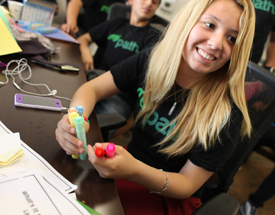From its beginning, MyPath has developed its programs in partnership with the young people it seeks to serve and has relied on peer group coaching.
Background
MyPath started in 1989 as a program in a community development credit union serving a low-income membership in a largely immigrant Latino community in San Francisco. In 1996, the credit union secured a federal grant to create a youth credit union program, providing accounts for individuals from birth through age 18 years and opportunities for those 14 to 18 years old to be tellers. When youth reach 14 years of age, they can be sole owners of their accounts. By 2006, it was the largest savings program for children and youth in the San Francisco area, with more than 300 account holders and more than $200,000 in savings.

Young people attend MyPath financial literacy class to learn how to open bank accounts, create savings plans, and establish credit.
Photo Credit: MyPath
MyPath was formed as a nonprofit in 2007 and began to train 14- to 17-year-old youths from the neighborhood to be partners in a data-driven strategic planning process to guide the nonprofit's work. Youth teams analyzed data about the youth members' engagement with savings products, researched best and promising practices in the savings and asset-building fields, and gathered input about the financial goals of youth and parents in the community.
This participatory action research — which today might be called human-centered design — led to the design of MyPath's pilot in 2009 and 2010, which combined youth accounts, personal goal setting, savings incentives, and financial education designed by youth and integrated these ingredients into youth programs. In this pilot, MyPath learned that settings where youth are earning money are optimal for reaching them with a mix of banking and savings supports and for generating savings and savings habits.
Using Technology and People to Move from Pilot to Scale
From 2011 to 2013, MyPath conducted a second pilot with the San Francisco Mayor's Youth Employment and Education Program, which served 300 low-income youths during the school year with employment training and placement.
The innovative features of the model were:
- enrollment into two accounts1 integrated into program enrollment,
- enrollment into direct deposit with auto-split2 to make savings automatic,
- incentivized personal goal setting, and
- youth-designed financial education.
MyPath Savings, a program created by MyPath, generated powerful outcomes in banking, saving, and confidence among youth participants, as discussed in a 2013 working paper published by the Federal Reserve Bank of San Francisco.3 Further data analysis published in the Journal of Consumer Affairs4 showed that youth participants in MyPath Savings reported increased levels of self-efficacy and had a more positive future outlook.
With support from the Center for Financial Services Innovation, MyPath engineered key improvements to increase scalability,5 including:
- an online tool with three interactive money management modules,
- a technical assistance program to help partners create the infrastructure needed to run MyPath Savings,
- a train-the-trainer program to prepare staff at youth employment programs to deliver MyPath Savings curricula, and
- legal templates for both youth employment program and credit union partners.
Building Rigorous Evidence to Make the Case for Wider Adoption
MyPath engaged researchers from the Federal Reserve Bank of San Francisco, the Center for Social Development, the University of Michigan, and Eastern Washington University to conduct a quasi-experimental design study in which two scalable versions of MyPath Savings were tested against a comparison group. Participants ages 15 to 21 in both treatment groups received an in-person orientation, two accounts, direct deposit, a savings contract, and three interactive online money management modules. In addition, one treatment group also had peer coaches6 trained in leading in-person activities and discussions related to online content. Key findings from the study, as discussed in a 2016 working paper published by the Federal Reserve Bank of San Francisco,7 include:
- Both MyPath Savings models generated strong banking, savings, and money management behavior outcomes among youth participants.
- Youths in both treatment groups were three to five times more likely than those in the comparison group to have increased confidence in carrying out basic financial behaviors.
- Adding peer coaches resulted in youths being nine to 11 times more likely than those in the comparison group to have statistically significant increases in financial knowledge and the adoption of more sophisticated financial management behaviors.
Several important lessons were learned from this scalability study:
Lesson 1: More scalable MyPath Savings models improve youth financial capability.
Both treatment groups had high engagement with banking, goal setting, and saving and significant improvements in money management practices compared with the comparison group. Adding peer coaches boosted financial knowledge gains and adoption of some financial practices. This demonstrates the power of a financial capability–focused intervention in achieving outcomes versus the more traditional financial education workshop approach.
Lesson 2: Strategies must blend in-person and online approaches.
Blending in-person and online education proved to be an effective strategy to engage low-income working youth in putting new financial practices into action. The blended model provides an effective mix of scalability and impact. Technology can help scale programs, and the in-person activities solidify learning. Although there has been much focus on the proliferation of apps and online gaming approaches, this study shows that they cannot be stand-alone approaches.
Lesson 3: Low-income young people will bank and save when the right supports and products are embedded in their employment or workforce programs.
Young people bank and save when given the opportunity to open accounts that are "youth friendly." The strong take-up and account enrollment rates for both treatment groups reflect the impact of using the MyPath youth banking standards with partner financial institutions to create financial products that are tailored for youth and that reduce youth banking barriers. For example, the standards include small minimum balance requirements and acceptance of school IDs. The train-the-trainer approach also helped generate these outcomes because youth employment program staff who are "trusted sources" of information are a reliable channel for introducing youth to the financial products and programs. These trusted sources are key because they help overcome young people's resistance or hesitancy about banking. Finally, enrollment was high because MyPath Savings was embedded in the youth employment program processes.
Lesson 4: Youth employment and workforce systems are strategic delivery channels and require different financial curricula than those designed for classrooms.
The MyPath Savings curriculum is tailored for youth employment and workforce settings and staff in that it is shorter than classroom-based curricula and designed to engage young people earning their first paychecks in banking and saving products. MyPath's train-the-trainer program leads youth employment and workforce program staff to deliver financial capability rather than provide financial education and provides support and tools to lead the activities with their youth participants.
Lesson 5: Transforming income into savings changes youth mindsets.
The study reveals some powerful shifts in young people's mindsets at the end of the program when they have set and met a personal savings goal. Improved financial confidence and self-efficacy help build a savings habit, which leads to upward economic mobility.
Using These Key Lessons to Drive Adoption and Engineer New Models
MyPath has designed a model that combines savings and credit building for working young adults between the ages of 18 and 24 years. From 2014 to 2016, MyPath has operated MyPath Credit in San Francisco and Oakland, CA, with 121 young people with sponsorship from the Federation of Community Development Credit Unions and the Center for Financial Services Innovation and funding from the Kresge Foundation.8 The only youth-focused credit-building program in the country, its early results are significant:
- Young adults who started the program with no credit at all had FICO scores of 699 plus at completion.
- Participants exited the program with emergency savings of $500, providing a measure of financial security and easier access to employment, housing, and affordable borrowing.
- Participants experience statistically significant increases in financial knowledge and financial self-efficacy.
Full evaluation results conducted by researchers from the University of Georgia are forthcoming.
Movement to Increase Scale
The U.S. Treasury, the Consumer Financial Protection Bureau (CFPB), and the U.S. Department of Labor held a national meeting on integrating financial capability into youth workforce programs in 2013. Following that meeting, both private and public investors have supported efforts to bring these best practices to more cities across the country. Meanwhile, the U.S. Department of Labor, in implementing the Workforce Innovation and Opportunity Act (WIOA), will require the inclusion of financial education into youth workforce programs in July 2016. The CFPB launched its Youth Employment Success (YES!) initiative last fall to provide technical assistance to two dozen locations9 across the country to support efforts to address the new WIOA financial literacy requirement. CFED and MyPath are providing technical assistance to this diverse group of cities across the country to enable youth employment systems to lead to upward economic mobility.
MyPath has developed innovative models to engage low-income working youth between the ages of 16 and 24 years in banking, saving, and credit building through youth employment and workforce systems. Policymakers, regulators, funders, and local leaders are shifting their focus from financial education to financial capability and are looking for evidence-based approaches that can be delivered by city and nonprofit program staff. The WIOA requirement presents an important opportunity to apply lessons learned in how to achieve financial capability and put more low-income youth on a path to upward economic mobility.
The views expressed here do not necessarily represent the views of the Federal Reserve Bank of Philadelphia or the Federal Reserve System.
[1]Both were savings accounts, but one had a temporary restriction placed on it. The account funds couldn't be accessed until the end date of the program, or the youths wouldn't be eligible for incentives.
[2]Auto-split means each paycheck is direct-deposited into two accounts, according to the youth's individual MyPath savings goals (e.g., 80 percent into the regular account and 20 percent into the restricted account).
[3]Vernon Loke, Margaret Libby, and Laura Choi, "Increasing Financial Capability Among Economically Vulnerable Youth: MY Path Pilot and Year Two Updates," Working Paper 2013-03, Federal Reserve Bank of San Francisco, December 2013, available at www.frbsf.org/community-development/files/wp2013-03.pdf.
[4]Vernon Loke, Laura Choi, and Margaret Libby, "Increasing Youth Financial Capability: An Evaluation of the MyPath Savings Initiative," Journal of Consumer Affairs, 49:1, February 2015, pp. 97–126.
[5]In addition to San Francisco, this program has also been implemented in Reno, NV, Ferguson, MO, and San Jose, CA; planning is underway to roll out the program in three other communities in 2016.
[6]Margaret Libby, "Financial Coaching for Youth and Young Adults," in Jonathan Mintz (ed), The Professionalizing Field of Financial Counseling and Coaching: A Journal of Essays from Expert Perspectives in the Field, New York: Cities for Financial Empowerment Fund and Citi Community Development, 2016, available at www.professionalfincounselingjournal.org.
[7]See Vernon Loke, Laura Choi, Lauren Larin, and Margaret Libby, "Boosting the Power of Youth Paychecks: Integrating Financial Capability into Youth Employment Programs," Working Paper 2016-03, Federal Reserve Bank of San Francisco, April 2016, available at www.frbsf.org/community-development/files/wp2016-03.pdf.
[8]See MyPath, "Two-Year Study Demonstrates MyPath Savings Works," available at http://mypathus.org/wp-content/uploads/2014/09/QUICK-SNAPSHOT-of-Boosting-the-Power-of-Youth-Paychecks.pdf. MyPath Credit was one of three partnerships funded by the Financial Capability Partnership Initiative, which sought to develop new models that deliver community development credit union financial products in social service settings. For information on the initiative, see Center for Financial Services Innovation, "Partnerships for Financial Capability: Diagnostic Frameworks for Financial Institutions and Partners," September 14, 2015, available at www.cfsinnovation.com/Document-Library/Partnerships-for-Financial-Capability-Diagnostic-F.
[9]These areas include Middlesex County, NJ, and Philadelphia.

